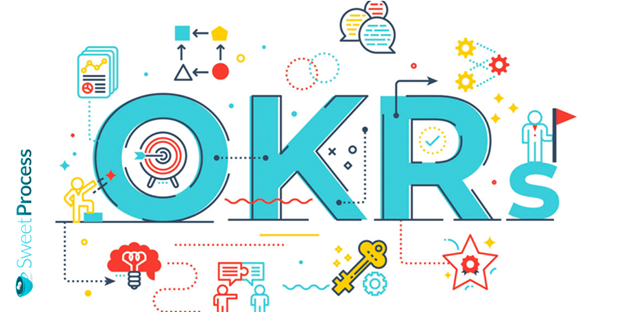Last Updated on November 22, 2024 by Owen McGab Enaohwo

Every year, companies set up ambitious goals and objectives that need to be achieved by each team member, department, and the entire organization. However, most fail to meet these targets due to ineffective processes.
When your business objectives backfire, it’s time to analyze your goal-setting process and areas that need improvement. The failure rate increases if the entire organization is not aligned, which means that every team member is not moving in the same direction, and there are no clear priorities.
Most companies fail because they don’t involve employees in the goal-setting process. A Harvard Business Review report shows that less than a third of senior executives communicate the company goals with the team. Because of this lack of communication, 30% cite lack of coordination across departments as the biggest challenge in executing company strategy.
To avoid such pitfalls, the most successful organizations globally have adopted an objectives and key results (OKR) goal-setting framework that creates alignment and tracks the progress of measurable goals. This process breaks down goals into smaller focus areas that can be easily tracked.
If you compare companies with an OKR strategy to those without, the output and overall performance is quite different. Employees who use OKR:
- Are more effective at their jobs.
- Have better performance at work.
- Contribute to increased sales.
If you want to develop an effective OKR process for your business, this article will provide information about how to write them, the benefits, the different types, valuable examples, common OKR mistakes, and the differences with key performance indicators (KPIs).
Chapter 3: How to Write Effective OKRs
Chapter 5: Key Tenets That Will Make Your OKRs Work
Chapter 6: Useful OKR Examples
Chapter 7: Benefits of Using OKRs
Chapter 8: Common OKR Mistakes
Chapter 10: Differences Between OKRs and KPIs
Chapter 11: FAQs: Frequently Asked Questions on Objectives and Key Results
Chapter 12: Let SweetProcess Help You Achieve Your OKRs
Chapter 1: What is OKR?

OKR, or objectives and key results, is a collaborative goal-setting framework used by individuals, teams, and companies to set ambitious and measurable goals that can be tracked. This framework helps companies implement and execute their strategies. They also help the leadership communicate the entire plan to employees in a measurable way. OKRs are set quarterly, making it easier to track progress.
History
The OKR methodology can be traced back to 1954 when management consultant Peter Drucker introduced the management by objective (MBO) concept. The MBOs were further developed by the co-founder of Intel, Andy Grove. Grove redefined the MBOs into what we know today as OKRs. However, this theory was still known as Intel Management By Objectives ( iMBOs).
Grove popularized this concept during his tenure at Intel. In 1975, John Doerr, then a salesman working at Intel, attended a course by Grove which focused on the OKRs concept. Doerr learned the idea and later introduced it to Google founders while working at a venture capital firm, Kleiner Perkins, in 1999. Doerr presented this methodology to the founding team, including Larry Page, Sergey Brin, Salar Kamangar, Marissa Mayer, and Susan Wojcicki, which quickly became the center of Google’s culture.
OKR became popular at Google and is still used to date. Other tech organizations have also adopted the concept, including Uber and Microsoft.
What OKRs Are Not
OKRs have a poor reputation in organizations because they are often used incorrectly. To develop an effective goal-setting process for your company, you need to know what OKRs are not.
- OKRs are not the same as KPIs; therefore, they shouldn’t be used to measure business results as usual.
- They are not used to highlight people missing targets.
- OKRs are not implemented to micro-manage teams and employees.
- OKRs should not be used as a tool to measure reward and compensation. This is demotivating and kills ambition.
- This goal-setting framework should not be used as a “set and forget” strategy.
Chapter 2: OKR Best Practices

When creating an effective OKR process for your business, you should follow some best practices for the best results. Let’s examine these practices.
Setting the right goals is the secret to success.
Target 70% Success Rate
According to Doerr’s book Measure What Matters, he recommends that an organization’s success rate for key results should be targeted at 70%. A company with a 70% success rate encourages competitive goal-setting and stretches the employees at low risk. However, if the organization meets the key results consistently at 100%, the parameters need to be re-evaluated.
Avoid Business As Usual
Business as usual refers to when a company executes its standard of operations normally without introducing programs or projects that might spark change. Organizations should ensure that their OKRs don’t represent business as usual. When this happens, the objectives are not inspirational or actionable.
An effective OKR avoids using words such as “assist” and “consult” because they describe vague activities and don’t demonstrate any measurable outcomes.
Focus on Measuring Leading Indicators
During the development of key results, organizations should focus more on developing leading indicators rather than lagging indicators. Leading indicators are ideal because they are measurable; therefore, they give organizations a heads-up when processes are not going the right way, enabling them to take corrective measures.
On the other hand, lagging indicators are metrics that can’t be connected to any changes in the organization. This makes it hard to course correct in real-time.
Use for Individual and Team Goal-Setting
OKRs should be used for both team and individual goal-setting. This tactic comes in handy for knowledge workers to help them prioritize projects in a fast-paced environment. OKR is a vital tool in an organization because it helps prioritize initiatives. Therefore, when the individuals and entire team are aligned on what needs to be done, the whole organization will move forward in the same direction.
Put Customers First
When setting OKRs for your company, you need to put the customer first. All the objectives and key results should be tailored to benefit the customer. This goal-setting tool is critical for the functioning of the entire organization. Therefore, if the company meets its key results, the customer will be satisfied.
Tie the OKRs to the Bigger Company Goals
OKRs developed for individuals and teams should be tied down to the larger company goals. This framework is developed quarterly, but it needs to connect with the overall annual objectives. For instance, if each department has key results to be met, they should also represent the company’s ambitions.
Assign KR Owners
All the key results should be assigned to specific people in the company. When creating each key result, you should have staff responsible for following up. This is important because it helps track progress. The key results (KR) owners can also identify when the team or individuals are going off track and recommend focus areas. In addition, this boosts accountability and motivates the employees to work on the goals.
Chapter 3: How to Write Effective OKRs

If you plan to write OKRs, you need to learn how to write them properly. OKRs are written as one objective at the top with three to five supporting key results. They can also be written as a statement. Here’s how to write effective OKRs.
Writing Company Objectives
To start off, you should draft a company objective. This objective is the high-level improvement area that different teams in your company will be working on. The company objective should be broad to allow all teams to brainstorm the most effective team objectives. On the other hand, it should also be specific for everyone to get clarity on what the company direction is.
When developing these high-level objectives, the leadership team should request feedback from all the teams. In addition, they should also clarify expectations to ensure that everything is clear enough.
Writing Team Objectives
An objective is typically what needs to be achieved. Once the company objectives are clear, the organization should develop specific team objectives. These inspirational goals should be aligned with the overall company direction.
These objectives provide focus, a sense of urgency, and team purpose. In addition, they are designed as problems that need to be solved or improvement opportunities to pursue within the quarter. If a team is working on the same outcomes, they should write their collaborative OKRs together.
Writing Key Results to Your Objectives
Key results monitor how you’ll achieve the objective. Therefore, they should be time-bound, specific, realistic, and measurable. While the objective is the problem to be solved or improved, key results show whether the problem has been successfully solved.
Under every objective, a team needs to set the three to five key results that measure outcomes and represent any valuable change in the company. When developing key results, keep in mind that they are not activities that need completion but the desired outcomes.
Chapter 4: Types of OKRs

OKRs are categorized into different types. Therefore, companies should pick the one that works best for them.
Aspirational OKRs
Also known as stretch goals or “moonshots,” aspirational OKRs mean that the team might not hit all the key results, but they’ll put in the effort. Most of these have not been achieved before; therefore, teams and organizations have to forge a new path. These OKRs are long-term and most likely to exist beyond the OKR cycle.
Aspirational OKRs are harder to accomplish but necessary for the organization because they push teams to think outside the box. They are more visionary, experimental and innovative; therefore are developed when an organization is pursuing new opportunities. While they might not be achieved 100%, they are essential for ongoing improvement and growth.
Committed OKRs
Just like the name, committed OKRs are team commitments. They are fixed OKRs; therefore, the company and teams must achieve them at the end of the cycle. These are the targets you are expected to meet, so they’ll have a passing grade. Therefore, when creating OKRs, this category should only have key results that you know you can achieve.
Learning OKRs
These OKRs are important when the team plans to learn something new at the end of the cycle. If a team or the company doesn’t have solutions for a particular problem, they can set up some key results to enable them to learn. At the end of the cycle, the results can be used to develop committed or aspirational OKRs in the next cycle.
The expectation of a learning OKR is to report findings that prove or disprove a hypothesis. The most important step in writing these OKRs is to identify the information that will give you intelligence on the way forward.
Strategic OKRs
Teams in a company need to work on different rhythms. To make this possible, you can use strategic OKRs set annually by the C-suite executives. These OKRs focus on the bigger picture for the organization.
Tactical OKRs
Tactical OKRs are similar to strategic ones. However, instead of focusing on the entire company, they are more low-level. They are meant for teams working on individual projects.
Chapter 5: Key Tenets That Will Make Your OKRs Work

Although OKRs look simple, they are not easy to implement, especially if you are a beginner. You need to know how to make them work. John Doerr uses his experience in helping companies develop OKRs to develop some essential lessons to help them work. Here are seven key tenets.
Bottom-Up Goal Setting
An organization with bottom-up management involves all the employees in the goal-setting process. In this type of work environment, most of the decisions and processes are largely influenced by feedback from the employees. When people choose their own goals, they are more likely to accomplish and see them through.
Doerr recommends that during the development of OKRs in an organization, individual members of staff and teams should come up with their own goals in consultation with the management. This is a more effective process than having all the decisions and objectives coming from the top executives.
Less is More
When creating an OKR, the recommended writing procedure is one objective and three to five key results. Doerr recommends that organizations should stick to these numbers. If you have more than five key results, it affects the focus and clarity of your OKRs. Therefore, it is essential to keep track of these recommendations to succeed in your company.
Choose the most actionable objectives and select key results that can be tracked easily. This tactic narrows down your teams’ focus to know which project or work is the priority.
Inclusive and Collaborative Process
If your organization has a top-down approach in all its functions, the OKRs creation process should be more inclusive and collaborative. Instead of dictating and issuing orders to employees at the lower management level, executives should have a collective process that ensures everyone is heard.
The teams will not own the process when you focus more on issuing directions from the top. In addition, it also lowers their motivation, making it harder to achieve company and departmental goals.
Flexibility
OKRs are not meant to be static. You need to create an agile solution that is adaptable to different environments. The importance of this is that if the key results don’t make sense at one point, you can discard or modify them mid-cycle to ensure that the company meets its objectives.
Objectives are typically long-term, but they can also be shifted to adapt to new changes. For instance, if your industry has a new competitor who is threatening your market share, you can change the objectives and shift priorities to enable you to compete effectively. If your company or teams are not flexible, your OKRs will become irrelevant over time.
Separation From Monetary Incentives
John Doerr advises companies not to tie the OKRs to monetary incentives such as salaries, promotions, and bonuses. These key results should not be linked to compensation of any kind. If you implement this in the company, employees will be incentivized to play it safe. Therefore, they will not perform beyond a certain point as long as they have hit the key results.
The “Father of OKRs,” Andy Grove, said OKRs are meant to pace your teams. Employees should use them as a stopwatch to gauge their performance. They should not be treated as legal documents to do performance reviews. Therefore, if you want to analyze your team’s performance, you should use other indicators rather than OKRs.
Goals That Are “Stretched”
Doerr’s book says that your OKRs should have a 70% success rate. If you are achieving 100%, it means that your objectives and key results are too simplistic, or you are playing it safe, making it easier for the company to hit them.
A good OKR strategy should stretch out your team and company to achieve more than it is now. The goals should be beyond what you are capable of. If some of the OKRs make you and your team uncomfortable, you are on the right track. You should always aim to solve problems and effect new changes; otherwise, it will be business as usual.
Patience
Setting OKRs for your organization is challenging. If it’s your first time, you’ll experience a lot of trial and error before getting it right. Remember that the strategies and tools that worked at big companies like Google and IBM will not always work for you. You have to be flexible enough to try out different types of OKRs until you find one that fits your business.
You are also less likely to get it right the first time. This is why you need the patience to succeed. After one strategy fails, you need to constantly re-evaluate the mistakes and adjust your approach in the next cycle.
Chapter 6: Useful OKR Examples

If you don’t know how OKRs work, you can learn from companies that already have these processes in place. This is important for beginners, especially since OKRs can be quite confusing. You should have company-wide and team-specific OKRs. Here are some key examples to clarify what OKRs are.
Company-wide OKRs Examples
Here’s a sample company-wide OKR from Allbirds, a popular clothing company, as part of their commitment to sustainability.
Objective
Create the lowest carbon footprint in the industry.
Key Results
- KR1: Supply chain and shipping infrastructure 100% zero waste.
- KR2: Pay 100% carbon offset for calculated carbon dioxide emissions.
- KR3: 25% of material is compostable.
- KR4: 75% of material is biodegradable.
Here is a template you can use to develop your OKR.
Team-Specific OKRs Examples
Apart from the management, you can have OKRs to guide functional teams. Here are some examples for specific teams.
Sales Team OKR Examples
Objective
Improve the sales performance for the entire team.
Key Results
- KR1: Improve conversion rate from 20% to 35%.
- KR2: Increase follow-up email rate from 15% to 45%.
- KR3: Upsell and cross-sell 30% of new business to existing customers.
- KR4: Maintain sales to at least $300,000 every quarter.
Marketing OKR Examples
Objective
Increase our brand awareness and reach.
Key Results
- KR1: Increase our social media following by 15X.
- KR2: Write and distribute one thought leadership article every week.
- KR3: Target two earned media PR placements in the local magazines each quarter.
- KR4: Increase the subscribers to our newsletter to 1,000.
- KR5: Create two new blog posts every week.
Product Team OKR Example
Objective
Launch a new product into the market by the end of the quarter.
Key Results
- KR1: Improve sign-up to conversion rate by 20%.
- KR2: Review customer feedback by conducting weekly surveys.
- KR3: Conduct at least 20 interviews with early adopters.
- KR4: Organize three training sessions with the marketing and sales teams.
Human Resources OKR Example
Objective
Retain top employees to reduce turnover rate.
Key Results
- KR1: Introduce bi-weekly training sessions to boost employee knowledge.
- KR2: Conduct monthly employee surveys to identify improvement areas.
- KR3: Review pay rates and compensation packages for the quarter.
- KR4: Increase employee satisfaction by 25%.
Operational OKR Examples
Objective
Improve the quality of our products.
Key Results
- KR1: Reduce the average QA rejections by 5%.
- KR2: Reduce the number of bugs on our products.
- KR3: Improve delivery time by 30%
You can use this sample Excel template to create your company OKRs.
Chapter 7: Benefits of Using OKRs

Companies that use OKRs in their business functions, such as Airbnb, Google, and LinkedIn, continue to achieve excellent results and remain profitable. OKRs are beneficial to individual employees, teams, and the entire company.
OKR guru John Doerr uses the acronym FACTS to describe the benefits of implementing this strategy in your organization. What does FACTS represent? Let’s break it down.
Focus
Setting OKRs enables the team to rally behind one course of action. This makes it easier to stay away from things and functions that are not a priority. The important element of using OKRs is connecting the team objectives to the company’s overall goals. Aligning all your objectives as a company ensures that everyone works on one project.
In addition, every team member understands all the key results and how they influence its overall performance. To make this work, ensure that you communicate to the entire team.
Alignment
OKRs are also important because they provide a method for the entire company to align its quarterly goals at every level. Since everyone knows the priorities, they’ll be more organized in their work execution. Therefore, it’s not enough to write the goals without ensuring all the employees are on board. A proper alignment strategy requires top-down and bottom-up communication.
The leadership should first develop the overall OKRs that communicate the company direction. Then the teams should have their own input and write their quarterly OKRs. When this is done, each team member will feel involved.
Commitment
For OKRs to succeed, all parties must have a high level of commitment. Once everyone is aligned on what is to be achieved, the work begins. If your employees are not committed to the OKRs, there will be gaps, and most of the key results will not be effective at the end of the cycle.
Find ways to keep everyone motivated to achieve company goals. If everyone is happy, they will stick to the set priorities.
Tracking
When your organization is guided by OKRs, tracking the progress and identifying flows becomes easier. Tracking helps with accountability and transparency, and uncovers problems that need to be addressed early enough to achieve the goal.
Functional teams can organize weekly check-in meetings to monitor progress and check whether the OKRs are on track. These regular meetings are crucial in providing a regular update and exchanging information between team members, which builds trust. However, these meetings should be short, about 15 minutes, to allow employees to perform their jobs.
Statistics show that 65% of employees agree that meetings take up so much time, preventing them from completing their work. Schedule short weekly meetings to boost the accountability process in the company.
Stretching
One of the major principles of OKR is that teams and companies should set goals that go beyond “business as usual.” As Doerr suggests, the key results success rate should be about 70%, not 100%. This means that the goals should be better than what the company is currently doing. If your team meets every quarterly objective, it’s time to review and stretch them further.
When your organization has bigger goals, the entire team works extra hard to achieve them. This will positively contribute to the overall output and performance. In addition, it keeps the employees motivated as they work to meet the set objectives.
Chapter 8: Common OKR Mistakes

Setting OKRs requires a lot of practice. For your organization and teams to stay focused on the company priorities, you have to develop clear and measurable goals. Each set of OKR, whether company-wide or team-specific, should undergo multiple checks and include feedback from every team member. Here are some of the common mistakes people make when writing OKRs.
Lack of ambition
Your OKRs should be as ambitious as possible. The whole point of drafting these goals is to “shoot for the moon.” These goals should push and inspire your teams to be greater and achieve more. However, they should not be impossible. Ensure that the goals are not too simplistic and your teams are stretched.
Not setting a clear difference between aspirational and committed OKRs
The OKRs in your organization can either be aspirational or committed. Aspirational OKRs are stretch goals that push the team to think outside the box while committed ones are fixed and have to be met. Your teams need to know the difference between the two and what’s expected of them.
Having vague and low-value OKRs
OKRs should bring value to your business. Therefore, if you have low-value goals, you’ll waste a lot of company resources for no results. You’ll also achieve the objectives within the cycle, which does not affect any changes to your organization. Always ensure your goals are clear and high-value for the best results.
Sandbagging
A sandbagging strategy limits your growth as a company. Once you lower your expectations, the teams will achieve the goals without positive change. Functional teams that meet all their OKRs are not stretching enough or hoarding resources. This mistake will cost the growth of the company in the long run.
Creating business-as-usual (BAU) OKRs
OKRs should boost your company operations to be above the status quo. If your team’s OKRs are written without changing anything they are currently doing, they are business as usual goals. Your goals should include top efforts and push the team to innovate and be more efficient.
Insufficient key results
Ideally, your key results should effectively make it possible to achieve the objective. Therefore, if one or more key results does not represent the goals well, your OKR will not succeed. When this happens, it can cause delays, and the objective will not be achieved on schedule.
Using OKRs as a task list
OKRs are not a task list; therefore, they should not be used to check whether you are delivering tasks. Instead, OKR is meant to measure whether you are adding value to your teams and the entire organization.
Not aligning with others
Ideally, OKRs are alignment tools; therefore, they should not be set in isolation. As the leader, you have to talk to all the teams on every level. In addition, the teams need to consult with each other to have clear goals. Communicating these goals to everyone is vital in achieving them.
Setting too many of them
Your key results should be between three to five for every objective for them to be effective. Most people make a mistake when writing OKRs by drafting too many. Having too many OKRs affects your allocation of resources to where they are needed the most. Organizations and teams that split their focus to too many goals are less focused and ineffective.
Lack of regular assessment and follow-through (setting and forgetting OKRs)
Once you set the company goals, you need to regularly follow up to confirm that you are on the right track. If you set and forget, the objectives will not be achieved at the end of the quarterly cycle.
Chapter 9: OKR Software

It can be challenging to draft OKRs for your organization as a beginner. To make it easier, there are different OKR software and management tools that boost alignment between teams and help with goal tracking. Here are the top ones you can use.
SweetProcess
The SweetProcess software gives you a platform to document your procedures, master your processes, and manage tasks. You can develop your OKRs using this software that makes it easy to collaborate in real-time, assign and track tasks, and manage all your processes and procedures on one platform.
Perdoo
If you sign up for a Perdoo account, you can access their software that enables you to execute your strategy and grow your company using OKRs. Instead of tracking your OKRs using spreadsheets, you can access their content for free. Their software is also free. Once you sign up, companies can access default and custom templates on the Perdoo software that they can use to keep track of their goals.
Koan
Koan offers a free modern OKR management tool that individuals and organizations can use to scale their goals and strategies. Their software makes it easy to track progress and reduces time spent looking for updates. To access the Koan OKR tool, you have to sign up. The Koan software provides templates for organizations and teams to fill in their objectives and key results for the entire cycle.
Weekdone
The Weekdone OKR software comes in handy for goal-setting, weekly planning, tracking progress, and team engagement. You can also use it for team reporting, visualizing your weekly and monthly progress, and aligning your team. The software integrates with your project management tools for easier tracking. Teams can use this software to see everyone’s progress.
Kazoo
The Kazoo OKR software enables organizations to easily align, share, and measure company goals. Using the tool, you can create goals for each level, customize them to match your business, and collaborate on shared objectives across teams. Once the cycle is over, the results become available for every employee to see the progress. If there are issues, the teams can add one or more measurable key results to work on.
Heartpace
Heartpace offers an OKR module that comes with intuitive features tailored to your company’s specific needs. When you sign up, you can define the objectives and key results. The software allows 360-degree visibility on OKRs at all levels, which boosts collaboration. To get started, you can request a demo.
Lattice
The Lattice OKR software provides a speedy and seamless platform to set, track and reflect on your company goals. The system integrates with your management software, making it easy to track your goals and progress. With Lattice, the management can track the progress in real-time and identify areas that need action. Companies can access templates on the platform to set their objectives and key results to be achieved within the quarter.
Profit.co
Profit.co helps companies and teams to define and execute their goals and strategies using their powerful software. The tool is ideal for task management, employee engagement, and performance management. Once you sign up, you can use the software for weekly check-ins, performance appraisals, and monitoring. In addition, it also comes in handy in streamlining project execution and organizing the teams to work on a common goal.
Chapter 10: Differences Between OKRs and KPIs

Objectives and key results (OKR) and key performance indicators (KPI) are vital in monitoring the goals in your company. However, their application is quite different.
Simple Definition of KPI
Key performance indicators (KPIs) are metrics used to track and measure performance within a project and evaluate the organization’s overall success. They are usually segmented across departments and teams and focus more on outcomes.
The best KPIs focus on outcomes rather than company activities. They should be set based on what the company wants to achieve at the end. KPIs measure how the company is performing as a whole while keeping functional teams accountable.
Simple Definition of OKR
On the other hand, OKRs are a planning framework used for setting and achieving goals. OKRs represent a target objective and define the measurable steps you’ll take to accomplish this goal. They are set at company and departmental levels.
OKRs are set quarterly instead of annually which allows the company to adapt much faster. Since they involve all employees at each level of management, they provide transparency and inspire teams to achieve the company goals.
List of Differences
| KPIs | OKRs |
| They are business metrics that measure performance | Goal-setting framework to achieve key results |
| Set by company leadership (top-down approach) | Uses both top-down and bottom-up approaches |
| Used for performance management | Used for employee engagement, alignment, and focus |
| Not flexible, cannot be changed regularly | Flexible, can be frequently re-evaluated and adjusted |
| Provides benchmarks to be met | Involves every team member on goals to be achieved |
| Tied to employees’ day-to-day work | Tied to business goals and objectives |
Chapter 11: FAQs: Frequently Asked Questions on Objectives and Key Results

What is an OKR?
OKR stands for objectives and key results. It’s a business methodology used by organizations, teams, and individuals to set goals that can be measured every quarter.
What’s the main difference between OKRs and KPIs?
One of the key differences between OKRs and KPIs is that OKRs are ambitious goals that change from time to time, while KPIs are typically obtainable indicators that measure performance.
Who’s in charge of an OKR program?
It’s advisable to have an ambassador who is responsible for program management and is the point of contact for the organization.
Can you create an OKR for something that can’t be measured?
Almost all objectives can be measured. Ensure that you choose key results that are based on output rather than input.
What’s the difference between SMART goals and OKRs?
These goal-setting frameworks differ in the way the goal is constructed. OKRs must be measurable, while SMART goals must be smart, measurable, achievable, relevant, and time-bound.
How many OKRS should you set?
While there’s no limit for how many OKRs you should set, you should aim to have no more than ten objectives. Each objective should have three to five key results.
Should a small business set OKRs?
Yes, all types of businesses should set OKRs to align their company goals.
Who invented OKR?
OKR was first introduced by Andy Grove but were known as MBOs. However, they became popularized by John Doerr, who introduced them to Google.
Chapter 12: Let SweetProcess Help You Achieve Your OKRs

The SweetProcess software helps businesses manage all their tasks and processes in one place. You can use it to document your procedures, master your processes and manage tasks. Using this software, you can develop your OKRs, making it easy to collaborate with your team in real-time, assign and track tasks, and manage all your processes and procedures.
Gretchen Pisano, CEO, and Jennifer Schneider, the chief design officer at pLink Leadership, help businesses accelerate their growth. Since the company is fully virtual, the entire team depends on one process to be efficient. However, they were encountering challenges with documenting and streamlining their procedures due to the absence of a well-documented process.
Documenting all their processes in an 85-page Word document was not efficient. This is how the two discovered SweetProcess software. The system helped them streamline their business operations, train new employees, and have an accessible central knowledge base.
The software also came in handy to help them scale and diversify company goals and OKRs. They can now integrate with other tools, making it easier to achieve business objectives.
The CEO of ShipCalm, Ted Fogliani, was keen to streamline business operations when he started the logistics company. However, he lacked an effective system that limited information available to employees to perform tasks. As the customer base expanded, Ted had management issues due to the absence of a solid workflow system.
To streamline the workflow, Ted turned to SweetProcess. The software helped with employee onboarding, business process documentation, and employee knowledgebase, making it possible for customers to share their experiences. He says, “I wanted to be able to write a procedure quickly, and I wanted anybody with a reasonable training skillset who could type to be able to do one very easily.”
SweetProcess has helped the company achieve its business goals, and the entire team is aligned on the set priorities. Their e-commerce operations became better than before.
If you want to create an effective OKR strategy, you can use SweetProcess. It’s available on the web, iOS, and Android. Sign up for a free trial of SweetProcess now! No credit card required.
Conclusion: Streamline Your Business With OKRs that Work
OKRs are important for every business. This framework makes it easy to align business priorities, focus on projects, and engage all employees.
Organizations with an effective OKR process achieve their goals much faster. You need to invest in developing an OKR framework for the entire company and functional teams for your business to achieve its objectives. If you want to start your journey to create a new OKR framework for your company, sign up for a free trial of SweetProcess today!
Download “The Must-Have OKR Checklist for Today’s Business” below to get you started!
